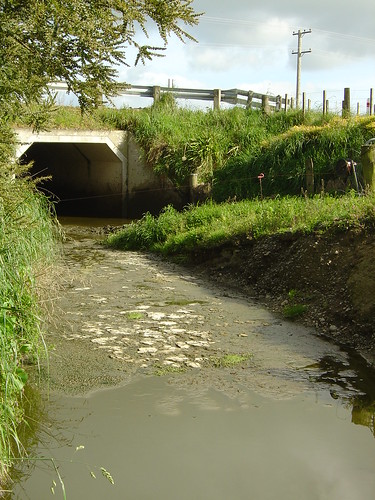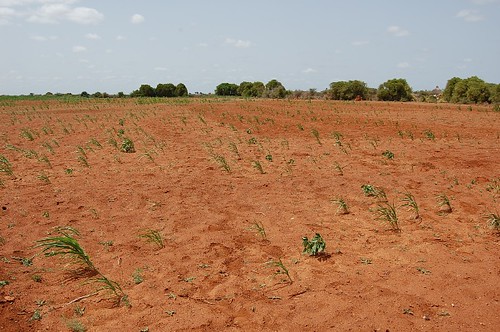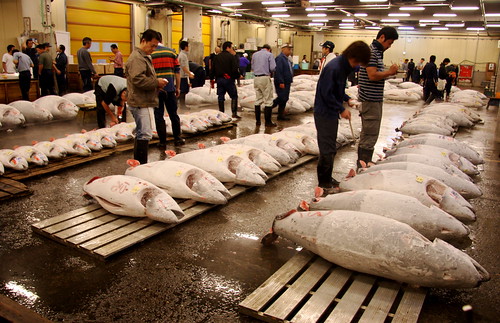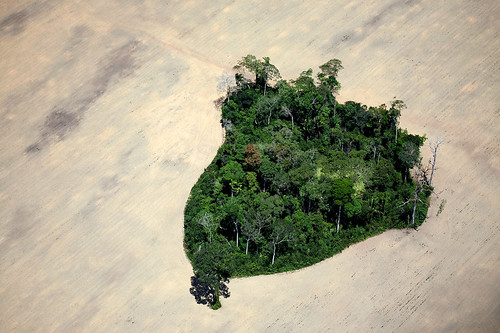
Today is World Environment Day, and this year's theme is related to food.
How is food relevant to the environment, you may ask.
Adopting environmentally-friendly practices in our daily lives can take on many different forms - whether it means reducing your energy consumption, reusing items like bottles and containers, or simply sorting your trash so that some of it can be recycled. But how many of us have really paused to think about the environmental impacts of the food we eat?
As urban residents, it is easy to forget where our food comes from. It may have been grown in a different climate, and shipped across oceans and continents to arrive on your plate. Young children growing up today might have never seen a live chicken or cow before, or might not know that watermelons grow on vines, not trees. As for the people who toil and labour to produce the food that we consume, they remain faceless and anonymous, cogs in the vast machine that is the global food distribution network. In many ways, we are ignorant of the stories that our food has to share. Only when some calamity stands to affect our food supply, whether it's avian flu cutting off the supply of poultry products from Malaysia, or floods in Thailand threatening the rice harvest, do some of us sit up and take notice. But for a nation that claims to love food, we can be remarkably oblivious as to where our food really comes from.
And our food supply is intricately connected to the state of the environment. For one thing, industrial agricultural practices can contribute significantly to pollution. Whether its manure from hog farms or runoff of fertiliser from croplands, increased demand for food has resulted in agricultural intensification, with severe impacts in many surrounding areas.

Waterway polluted by dairy farming operation, New Zealand;
(Photo by eutrophication&hypoxia)
Like all other species, the animals and plants that we depend on for food all require healthy environments, regardless of whether they are domesticated and raised on a farm, or harvested from the wild. Environmental problems like pollution, climate change, water scarcity and soil depletion are all issues that affect the health of our crops and livestock, leaving them more vulnerable to attack by disease and pests. Without healthy yields, food supply is threatened.

Failure of sorghum crop in Somalia;
(Photo by Vasco Pyjama)
Many of the plants we grow as crops are also reliant on other links in a greater network of interconnected beings - these are the pollinators, the bees, bats, birds and other animals that visit flowers and enable our crops to produce the next generation.
The most obvious way in which our choice of food can have a significant impact on the environment can be seen in the way in which many fish and other seafood species are being harvested at unsustainable rates, despite all the evidence that fishing needs to be reduced or even halted temporarily for stocks to recover.

Bluefin tuna at Tsukiji Market, Japan;
(Photo by eLjeProks)
And then there are those who choose to go vegetarian for environmental reasons - animal welfare reasons aside, it requires more resources to raise livestock and poultry than to grow crops. Not to mention that a large proportion of the food that could go towards feeding humans is being diverted to feed livestock instead.

Feedlot for beef cattle, North Dakota;
(Photo by NDSU Ag Communication)
However, even if you choose to go vegan, or eat only food that is certified organic, there is still another avenue in which your consumption patterns can have an effect on the environment. Which brings me to the theme for this year's World Environment Day: Think.Eat.Save.
Think.Eat.Save is an anti-food waste and food loss campaign that encourages you to reduce your foodprint. According to the UN Food and Agriculture Organization (FAO), every year 1.3 billion tonnes of food is wasted. This is equivalent to the same amount produced in the whole of sub-Saharan Africa. At the same time, 1 in every 7 people in the world go to bed hungry and more than 20,000 children under the age of 5 die daily from hunger.*According to a report released in January this year by the Institution of Mechanical Engineers (IMechE), as much as half of all the food produced in the world every year might be ending up as waste. And in latest news, more than half of the food lost and wasted in Europe, the United States, Canada, and Australia occurs at the consumption stage.
Given this enormous imbalance in lifestyles and the resultant devastating effects on the environment, this year's theme – Think.Eat.Save – encourages you to become more aware of the environmental impact of the food choices you make and empowers you to make informed decisions.
While the planet is struggling to provide us with enough resources to sustain its 7 billion people (growing to 9 billion by 2050), FAO estimates that a third of global food production* is either wasted or lost. Food waste is an enormous drain on natural resources and a contributor to negative environmental impacts.
This year's campaign rallies you to take action from your home and then witness the power of collective decisions you and others have made to reduce food waste, save money, minimise the environmental impact of food production and force food production processes to become more efficient.
If food is wasted, it means that all the resources and inputs used in the production of all the food are also lost. For example, it takes about 1,000 litres of water to produce 1 litre of milk and about 16,000 litres goes into a cow's food to make a hamburger. The resulting greenhouse gas emissions from the cows themselves, and throughout the food supply chain, all end up in vain when we waste food.
In fact, the global food production occupies 25% of all habitable land and is responsible for 70% of fresh water consumption, 80% of deforestation, and 30% of greenhouse gas emissions. It is the largest single driver of biodiversity loss and land-use change.
Making informed decision therefore means, for example, that you purposefully select foods that have less of an environmental impact, such as organic foods that do not use chemicals in the production process. Choosing to buy locally can also mean that foods are not flown halfway across the world and therefore limit emissions.
So think before you eat and help save our environment!

(Infographic: Click to enlarge and view in full)

(Click to enlarge)
Food waste is one aspect that Singapore needs to focus a lot more attention on. For a so-called food paradise, we do end up wasting a lot. According to the National Environment Agency, Singaporeans generated 0.7 million tonnes of food waste in 2012 alone! This represents a slight increase from 2011, which saw us throwing out 0.68 million tonnes. And while recycling rates for food waste improved slightly, from 10% to 12%, it still falls short of the target of having a recycling rate of 30% for food waste by 2012, as set in the Singapore Green Plan 2012.
As mentioned by Save Food Cut Waste, a local ground-up movement that aims to educate people, organisations and businesses in Singapore about the environmental and social impacts of food waste, and to encourage them to take action in reducing food waste:
Singapore's food waste output of 0.68 million tonnes is the only official figure published by NEA, and unfortunately it does not explain what the food waste comprises and where it comes from. In addition, supermarkets, food manufacturers, and food outlets are not forthcoming in divulging how much food waste they generate.
Perhaps it's the same old problem in which your eyes end up being bigger than your stomach. Or maybe we just can't pass up a good bargain and insist on ordering as much as we can.
I'm sure many of us have childhood memories of being chastised whenever we didn't finish our meals. For many parents, it seems like the common tactic is to mention the poor starving children of some famine-stricken country, appealing to their own children to count their blessings and consider themselves lucky that they face the problem of having too much food.

Thanks to years of nagging and cajoling by my parents, as well as my understanding of the resources and processes that went into producing the food on my plate, I am usually quite reluctant to waste any food. If I somehow order too much, or if my dining companions are unable to consume all the food they have, I try to finish as much as possible. It's probably not very good for my waistline, and it can be torturous if the food was horrible to begin with, but I strongly believe in not letting all the resources and labour that went into making my meal go to waste.
And it's not just about eating everything until your plate is completely empty. Households and businesses generate food waste in several ways. These include:
Food Waste from Cosmetic Filtering

(Photo from Food Waste Republic)
This takes place at all stages of the food transportation process, at the farm, wholesaler, market, restaurant, and home. Food that is not seen as aesthetically pleasing, or which harbours imperfections is discarded, even if it's perfectly edible. In 2010, it was estimated that 30 tonnes of unwanted vegetable parts and blemished fruits were being thrown out every day in Singapore.
Food Waste from Business Practices
Whether it's poorly trained cooks who ruin dishes and waste ingredients, creating diners who are unable to finish their meals out of dissatisfaction, inventory management that results in too much food being ordered, or simply a culture of preparing more food than can be sold, this is another avenue for food wastage. Back in 2010, Food From The Heart, a voluntary welfare organisation that channels unwanted bread from hotels and bakeries to needy families and individuals, collected approximately $150,000 worth of unsold bread and buns monthly, a volume enough to fill up around 900 supermarket trolleys. Businesses are also often reluctant to redistribute uneaten food and leftovers at the end of the day, because of potential issues with food safety and litigation over food poisoning incidents.

(Photo from Food Waste Republic)
Food Waste from Cultural Practices
For many of us, tradition mandates that for special occasions, such as weddings and ethnic festivals, a feast has to be served up for the guests. Even when guests are unable to finish their food, there are those who seem reluctant to pack leftovers, for fear of going against social norms or being regarded as greedy and taking advantage of the goodwill of the hosts.

(Photo from Food Waste Republic)
Food Waste from Homes
Just like restaurants that might order excess ingredients, there are households that inadvertently overstock, purchasing more food than can be eaten before it goes bad. Perhaps you forgot that you already told your spouse to get milk and you now have two cartons of milk in your fridge. Maybe you saw a good deal on bananas and bought 10 bunches. Or maybe you bought a can of sardines and left it in your cupboard for years. Whatever the case, overstocking and failing to keep track of the food means that some of it inevitably expires and is thrown out. And how many of us are guilty of throwing out food that is just one or two days past the expiry date?

(Photo from Food Waste Republic)
There are other factors that lead to high amounts of food waste, such as the need for supermarkets to have their shelves fully stocked with perishable food items, or poor storage practices that lead to unnecessary food spoilage. Personal dining habits also come into play here. Many of us are perfectly fine with packing leftovers from last night's dinner and having them for lunch the next day. But there are others who prefer not to keep any uneaten food. And when eating out, some of us have a tendency to over-order, resulting in more food than we can comfortably consume in one sitting. This is of course clearly illustrated by that phenomenon that many of us love, the all-you-can-eat buffet.

The Food Waste Republic website has a series of interesting feature articles that examine the food waste phenomenon in Singapore. A final-year project by three journalism students from the Wee Kim Wee School of Communication and Information at Nanyang Technological University, these articles look at how food waste is generated from seemingly innocuous everyday practices at the market, at the restaurant, and at home.
- The Era Of Supermarkets
- The Missing Profits
- Who? Me? I Waste?
- Dishing The Dirt On Banquet Waste
- Home, My Minimart
- The Food Waste Recycling Dilemma
- Forgetting About Food
Why is this an environmental problem?

As mentioned earlier, food waste represents a waste of the resources that went into production and distribution. It's important to think about the land and water used to sustain the crops and livestock, and the fertilisers, animal feed, pesticides, and medications that went into keeping them alive up until harvest and slaughter. Then there was the energy, likely generated from fossil fuels, that was expended in transporting, processing, and distributing the food, from producer to consumer, and let's not forget about the energy that went into the production process as well. All this requires plenty of labour and capital.

The Environmental Food Crisis, a publication by UNEP, mentions:
The demand for food will continue to increase towards 2050 as a result of population growth by an additional 2.7 billion people, increased incomes and growing consumption of meat. World food production also rose substantially in the past century, primarily as a result of increasing yields due to irrigation and fertiliser use as well as agricultural expansion into new lands, with little consideration of food energy effciency. In the past decade, however, yields have nearly stabilized for cereals and declined for fisheries.
[...]
The natural environment comprises the entire basis for food production through water, nutrients, soils, climate, weather and insects for pollination and controlling infestations. Land degradation, urban expansion and conversion of crops and cropland for non-food production, such as biofuels, may reduce the required cropland by 8–20% by 2050, if not compensated for in other ways. In addition, climate change will increasingly take effect by 2050 and may cause large portions of the Himalayan glaciers to melt, disturb monsoon patterns, and result in increased foods and seasonal drought on irrigated croplands in Asia, which accounts for 25% of the world cereal production. The combined effects of climate change, land degradation, cropland losses, water scarcity and species infestations may cause projected yields to be 5–25% short of demand by 2050. Increased oil prices may raise the cost of fertilizer and lower yields further. If losses in cropland area and yields are only partially compensated for, food production could potentially become up to 25% short of demand by 2050. This would require new ways to increase food supply.

Patch of rainforest surrounded by fields of soy, Brazil;
(Photo by Daniel Beltra)
The conventional way to increase food supply is to expand the area of land set aside for agriculture, which would ultimately mean clearing more of the Earth's remaining wild spaces, with a resultant devastating loss in biodiversity. Intensification of agricultural land, which often entails increased application of chemical fertilisers and pesticides, as well as clearing marginal habitats used by other species for the sake of increasing the amount of land subjected to the plough, is also likely to have a negative impact on biodiversity.
I don't know about you, but as much as I want to see an end to famine and hunger, I don't want to live on a planet fully converted to agriculture, devoid of all the wondrous habitats that have given rise to endless forms most beautiful, with no room for other species except for those that thrive because of (or in spite of) us. And with increased encroachment comes conflict with other species trying to survive in ever-shrinking islands of habitat in a sea of civilisation. In Kenya, African bush elephants and lions are often at the losing end of skirmishes with enraged farmers and herders. And closer to home, in Indonesia, large species like orangutans and Sumatran tigers end up incurring the wrath of people occupying land that up until recently was still covered in rainforest.

Lioness speared and mutilated after attacking livestock;
(Photo by Philip J. Briggs)

Veterinarian examining an injured Sumatran orangutan found on an oil palm plantation in Aceh;
(Photo by Binsar Bakkara)

(Infographic: Click to enlarge and view in full)
So... what can we do?
The EcoCentric Blog has an excellent post on tips that we as consumers can follow to reduce food waste. These are summarised in the infographic below:

(Click to enlarge)
On another note, I've found another project developed by final year students from the Wee Kim Wee School of Communication & Information at NTU. It's called makan mantra, and it seeks to raise awareness and education around the topic of food wastage in Singapore. It also aims to empower the public to take action on food wastage reduction and management. By introducing and implementing eight tips, known as 'mantras', in F&B operations, it is hoped that this initiative will encourage both food retailers and customers to take simple actions to prevent food wastage.

(Click to find out more about the eight mantras)
- Are you a S/M/L: Opt for a smaller portion if you know that the serving size will be too big for you.
The standard portion size may be too big for some of us. Opt for a size that fits your appetite and you might even have room for dessert. - Be original: Customise your order by removing or replacing ingredients you don't or won't eat.
We all have different tastes. Swap your fries for salad, or coffee for juice! By customising your order to suit you, you will enjoy your meal and finish it too. - Fill your stomach, not your plate: Fancy everything on the meny? Avoid stuffing yourself by finishing what is on your plate first.
Even if everything on the menu or the buffet spread looks tempting, can you really finish it all? Get just enough at a time to avoid wasting food. - Appreciate the little things in life: Side dishes may be small, but they are still food so don't forget to finish them.
Side dishes are often overlooked and wasted. They may not be the highlight of the meal, but they shouldn't be left behind. - Don't shy shy: Food you can't finish should never go to waste. Box it, wrap it, or pack it all up!
Request to take away food that you can't finish. You can enjoy it again, and you get your money's worth at the same time. But remember to refrigerate it within 2 hours and consume it within 4 days! - Slow and steady wins the race: it takes 20 minutes to register that you're full. So pace yourself. Only order more if you need to.
Do you know that it takes 20 minutes for your brain to realise your stomach is full? If you pace yourself, you will enjoy every bit of your meal and you are less likely to waste it too. - Ask the waiter: Not sure about your dish and what goes into it? Clear your doubts with the waiter.
Does it have pickles? Will it be spicy? Understand your order by asking the waiter because he knows best. - Be the change: Practise the mantras and take the first step towards reducing food waste. It all starts with you.
Big changes start small and it begins with you. Minimising food waste is something all of us can be part of. Keep it going by sharing the mantras with your friends and family.
Hopefully, you would have realised by now that reducing food waste is one of many ways to help reduce your impact on the environment; it's simple, straightforward, and easily adopted. What's more, it's good for the wallet too.
I'd like to end this post with a TED talk by Tristram Stuart, author of Waste: Uncovering the Global Food Scandal.
Resources:
Singapore-based projects and initiatives
Save Food Cut Waste
Food Waste Republic
makan mantra
Food For All
Food From The Heart
United Nations on food waste
UNEP Booklet for World Environment Day 2013
UNEP: The Environmental Food Crisis
FAO: Global food losses and food waste
FAO: SAVE FOOD: Global Initiative on Food Losses and Waste Reduction
(Cross-posted to SBA Plus. Do support me in the Singapore Blog Awards!)